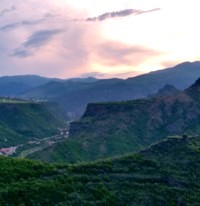Shamakhi
Our first stop on the way to Georgia was the ancient city of Shamakhi that was an important stop on the Silk Road. In Ancient Roman times it's mentioned in the writings of Ptolemy (Claudius Ptolemaeus; c. 100 – c. 170 CE) and by several European explorers from the 12th century onwards. In the 15th century the Venetian Giosafat Barbaro described Sammachi (sic) as:
"a good city; it has from four to five thousand houses, it produces silk, cotton as well as other things according to its tradition; it is situated in greater Armenia (Armenia grande) and the majority of its residents are Armenians"
On our way into Shamakhi we stopped at the Diri Baba Mausoleum (constructed in 1402) to entomb (Saint) Diribaba, a 'sacred person' (to Islam). Despite his relative modernity very little is known of this obviously much venerated person. Yet his mausoleum is still a place of pilgrimage and a centre for religious practice. It's now also an important tourist attraction; a climbing challenge and test of one's propensity to acrophobia. My confidence was boosted by the thought that someone else would be the first to reveal the fatal weaknesses in the ancient structures. They are apparently devoid of regular maintenance and have no obvious OH&S constraints, like handrails or barriers.
Diri Baba Mausoleum
A test of one's propensity to acrophobia
There are more images in the Azerbaijan Album See more...
In the 16th century Shamakhi fell to the Safavid (Persian) dynasty and the first capital of the state of Shirvan was founded and the population became increasingly Muslim. This region is actively volcanic and earthquakes can be violent so that the city has been destroyed several times. In addition there has been ongoing religious tension.
According to Wikipedia:
"In 1721, the Lezgins of the Safavid provinces of Shirvan and Dagestan, aided by the (rest of the) Sunni inhabitants of the area, sacked the city. They massacred thousands of its Shia inhabitants, apart from looting the city and robbing the property of its Christian inhabitants and foreign nationals, the latter which were mostly the city's many Russian merchants."
The Russians (under Peter the Great - see: Russia on this website) responded to these attacks on Russians by invading and restoring order but then withdrew, leaving it to the Ottoman Turks (Sunni), who then lost it to the Persians/Iranians (Shia) who were then, in turn, defeated by the Russians in 1813. As a result of all this, Azerbaijanis are predominantly Shia Muslims (nominally) and eventually ended up as part of the Soviet Union. None of this very confusing past was very clearly explained by our local guide who was more concerned to name a great many heroes of their local culture (that went in one ear and out the other) and tell us about the evil Albanians.
So he was keen to take us to the now very modern Juma Mosque, the largest and perhaps most destroyed mosque in Azerbaijan. It's on the site of Azerbaijan's oldest mosque, the Arab built Friday Mosque (743-744 CE).
God demolished it more than once with His earthquakes - presumably as a test for the faithful - of their perseverance. Then in the 12th century it was demolished by the (Christian) Georgians.
More recently it was burnt, while still in an unfinished state, by the evil Albanians who, according to our outraged guide, also incinerated hundreds of innocent women; children; and old men in the burning building. As the fire is well recorded on a stone in the grounds but there is no memorial to, or mention of, the dead, I was sceptical. Yet I subsequently found an undocumented reference to the massacre on-line - so it must be true.
Juma Mosque
On the site of Azerbaijan's oldest mosque, the Arab built Friday Mosque (743-744 CE)
There are more images in the Azerbaijan Album See more...

